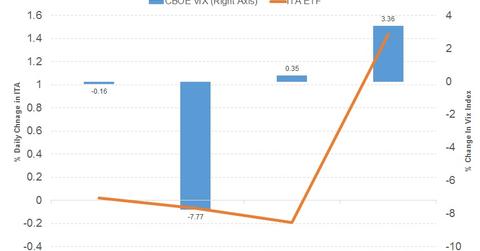What Stocks Should Be on Your Radar amid Geopolitical Tensions
Renewed tensions arising out of North Korea’s missile launch on Tuesday had a major impact on volatility. Asian markets have declined more than 1% as risk aversion dominated markets.
Aug. 30 2017, Published 3:52 p.m. ET

Volatility ETFs are set to rise again
Renewed tensions arising out of North Korea’s missile launch on Tuesday had a major impact on volatility. Asian markets have declined more than 1% as risk aversion dominated markets. The CBOE Volatility Index VIX (VXX), which is also considered a fear gauge, shot up 20% before US markets opened but ended the day with gains of 3.36% as US markets rebounded sharply.
The VIX index (VIXY) rose 14% in August, driven mainly by rising geopolitical tensions between the United States and North Korea.
Defense stocks to come back in focus
In uncertain times like these, demand for defensive sectors and defense companies go up. If these tensions continue to dominate markets, investors are likely to move to companies in the defense sector (ITA). Defense stocks like (BA)(LMT) have seen demand rise after Trump’s comments on Afghanistan in the previous week, and this demand is likely to increase amid geopolitical tensions. On August 29, aerospace and defense sector recorded gains of 1.72% after news of North Korea’s missile launch.
In times of volatility, defensive sectors like healthcare (VHT) and consumer staples (XLP) remain stable while growth stocks, which have seen massive demand in recent months, could suffer.
Outlook for equity markets
So far, there has been no military aggression after the missile launch from North Korea. Diplomatic measures in the form of further sanctions are possible after the emergency meeting of the UN security council. Will they lead to further escalation? That’s hard to predict. All investors can do is remain vigilant until these tensions subside. Equity market volatility arising from geopolitical tensions usually doesn’t last for extended periods, and this time is unlikely to be any different.
In the next part of this series, we’ll analyze the demand for safe havens after the North Korean missile launch.
